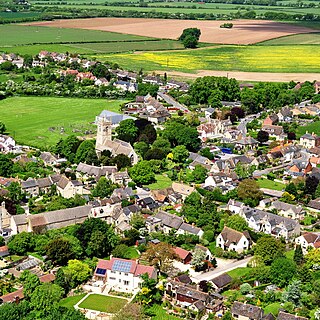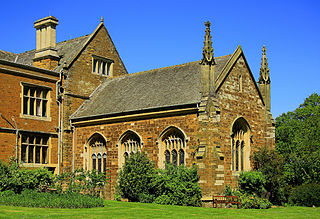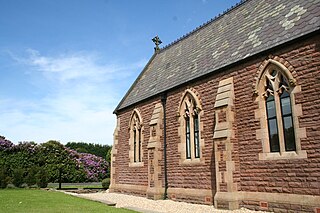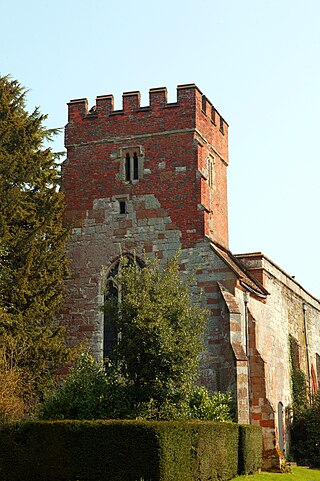
Oxfordshire is a ceremonial county in South East England. The county is bordered by Northamptonshire and Warwickshire to the north, Buckinghamshire to the east, Berkshire to the south, and Wiltshire and Gloucestershire to the west. The city of Oxford is the largest settlement and county town.

Clevedon Court is a manor house on Court Hill in Clevedon, North Somerset, England, dating from the early 14th century. It is owned by the National Trust and is designated as a Grade I listed building.

Lulworth Castle, in East Lulworth, Dorset, England, situated south of the village of Wool, is an early 17th-century hunting lodge erected in the style of a revival fortified castle, one of only five extant Elizabethan or Jacobean buildings of this type. It is listed with Historic England as a scheduled monument. It is also Grade I listed. The 18th-century Adam style interior of the stone building was devastated by fire in 1929, but has now been restored and serves as a museum. The castle stands in Lulworth Park on the Lulworth Estate. The park and gardens surrounding the castle are Grade II listed with Historic England.

Llanwarne is a village and civil parish in Herefordshire, England. The population of the civil Parish as taken at the 2011 census was 380. It is about 5 miles (8 km) from the Welsh border, is approximately 6 miles (10 km) north-west of Ross-on-Wye, and near Harewood End and Pencoyd.

Launde Abbey is located in Leicestershire, England, 14 miles east of the city of Leicester and 6 miles south west of Oakham in Rutland. The house was built on the site of the Augustinian Launde Priory. The Grade II* listed building is predominantly used as a conference and retreat centre by the Church of England dioceses of Leicester and Peterborough.

Temple Church, also known as Holy Cross Church, is a ruined church in Redcliffe, Bristol, England. It is on the site of a previous, round church of the Knights Templar, which they built on land granted to them in the second quarter of the 12th century by Robert of Gloucester. In 1313 the Knights Hospitaller acquired the church, following the suppression of the Templars, only to lose it in 1540 at the time of the Dissolution of the Monasteries. By the early 14th century, the church served as the parish church for the area known as Temple Fee. From around the same time, the rebuilding of the church on a rectangular plan started. This was completed by 1460, with the construction of a leaning west tower.

Old Gorhambury House located near St Albans, Hertfordshire, England, is a ruined Elizabethan mansion, a leading and early example of the Elizabethan prodigy house.

Langley Chapel is an Anglican church, built in 1601, located in a remote area approximately 1.5 miles to the south of Acton Burnell, Shropshire, England.

Exton Hall is an English country house on the western edge of the village of Exton, Rutland, England, standing in its own extensive park, and is the country seat of the Earls of Gainsborough.

Wroxall Abbey is a substantial Victorian mansion house situated at Wroxall, Warwickshire which was converted for use as a hotel, spa, wedding venue and conference centre. It is a Grade II listed building.

Kinnersley Castle in Herefordshire, England, is one of the many marches castles along the Welsh Borders.

Euxton Hall Chapel is situated in the village of Euxton, Lancashire, England. It was designed by architect E. W. Pugin (1834–1875), and built in 1866 as a private chapel for the Anderton family. Set within the grounds of Euxton Hall, and a Grade II listed building within its own right, the small Gothic chapel has been described as an architectural gem. Both English Heritage and the Ancient Monuments Society acknowledge that it is one of the important works of this architect. The Victorian Society has also recognised the building's national importance.

St John Clerkenwell is a former parish church in Clerkenwell, London, its original priory church site retains a crypt and has been given over to the London chapel of the modern Order of St John. It is a square, light-brick resurrection of the small church of Clerkenwell Priory – the crypt of which is beneath – without a spire or tower. Its three centuries of former decline reflected the disbandment of the medieval Order of St John, or Knights Hospitaller.
Stydd Hall (Castle) is a country house located near to the village of Yeaveley, Derbyshire, 15 miles (24 km) west of Derby, close to the A515 between Wyaston to the north, Great Cubley to the south, Yeaveley to the east and Alkmonton to the northeast. Stydd had formerly been an independent township but has all but disappeared: the hall and a farm are all that remains.

Dinmore Manor House is a large rural house in a well-wooded, hilly part of Herefordshire in the least populous parish of the county, Dinmore. It was substantially rebuilt in late 16th century, altered around 1830 and extended around the year 1928. The main house is a Grade II listed building. The outlying chapel is mostly medieval and is grade II* listed.

Wroxall Priory was a medieval monastic house in Wroxall, Warwickshire, England.
ROF Rotherwas was a Royal Ordnance Factory filling factory, No 4, located in Rotherwas, Dinedor Parish, Herefordshire, England.

The Rotherwas Room is an English Jacobean room currently in the Mead Art Museum, in Amherst College.

The Church of St Mary the Virgin in Pilton is the 13th-century Anglican parish church for the Pilton suburb of Barnstaple in Devon. It has been a Grade I listed building since 1951 and comes under the Diocese of Exeter.

St Mary's Bridge Chapel is a Church of England chapel in Derby, England. It is a bridge chapel, one of only a small number of medieval age that survive in England. It is a Grade I listed building.


















